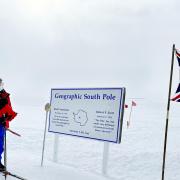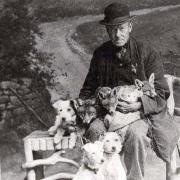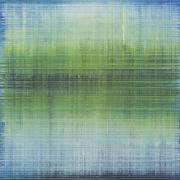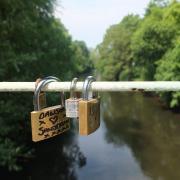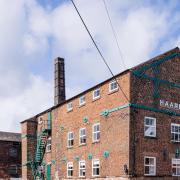Jane Woolrich designs have been a mainstay of the British lingerie scene for nearly 30 years. Derbyshire Life meets the internationally renowned designer and business woman at her premises near Swadlincote

As a child Jane Woolrich was fascinated by her grandmother’s gorgeous possessions; the intricately embroidered tablecloths and napkins, beautiful lace blouses and reams of elegant dresses.
She recalls with pleasure an occasion glimpsing her grandmother’s glamorous night wear spread on the bed of the Waldorf Hotel – a seminal and influential moment in the mind of a young girl who was destined to become a designer.
‘I loved anything vintage, embroidered and was crazy about clothes. I had a penchant for delicate fabrics and loved lace.’
Half a century later Jane is firmly established as a leading light in the international field of luxury lingerie and nightwear with her glamorous garments gracing prestigious stores across the globe from the USA to Russia, Europe and the Middle East. Her creations are worn by the wealthy, royalty and celebrities.

Jane has invited me to view her newly launched autumn collection for 2017, at the home of her business at Blakenhall Farm, in the heart of the countryside at the very southern tip of Derbyshire.
Her design label, which is her handwritten signature, had hinted heavily at what was to come. All that curvy cursive writing: so suggestive. Never in the history of a rounded capital ‘W’, has a letter seemed more like a pair of soft breasts or a generously proportioned bottom.
‘People remember the shape of my signature more than the sound of my name,’ she said.
Petite and classically neat in her L.B.D (Little Black Dress), a little investment from Saks in New York, Jane aged 62, shows me into the ‘pressing and packing’ room, stacked with rail upon rail of garments made from the finest silks, satins and chiffons, and swiss voiles each edged with hand-cut leavers lace.
It is a little overwhelming – akin to when the art lover visits Florence for the first time and is struck down with fever – because there’s so much treasure and beauty, artistry and craftsmanship to take in.
This season has a ‘Wedgewood’ collection, so named because it features night dresses and negligees of finest Swiss voile in delicate blues, a pale pistachio and a hint of pink. With their finely appliquéd lace detail and gentle romantic look the collection would not look out of place in a Victorian or Edwardian period drama.
By contrast there are overtly sexy, show stopping silk negligees and luxurious floor sweeping robes. There are night dresses redolent with Hollywood glamour; in colours you want to imbibe: buttermilks and champagnes. It’s the kind of stuff you imagine the Russian film star Olga Kaboo, who is one of Jane’s clients, to wear.
‘You don’t feel as if you are wearing anything when you wear these, they feel so light,’ says Jane. ‘It’s like a whisper on the body, that’s what people have said.’
There are seductive slips, handkerchief-hemmed floaty and flirty chemises, cute and young candy pink baby dolls, camis and French knickers, bralets and boy shorts, not to mention the thongs and high-sided knickers (beloved by the Russians and the American markets though avoided by the Middle East).
None of these things come at a snip of course. Fine silk, traditionally made leavers lace, expert couture and knowledgeable seamstresses all add up. A chiffon silk pyjama set, edged with luxury lace and made to order can cost as much as £691.
All of Jane’s nightwear pieces are cut on the bias to enhance curves and give the fabric stretch. And many pieces feature Jane’s signature lace-up back – a key aspect of her strong brand identity.
She said; ‘I designed the first lace-up back night dress in 1987 and I’m known for it.
‘It’s a strong look. People say they can tell one of mine a mile off. It’s not for everyone but those who like it, really like it. It’s a strength that people can always recognise my brand.’
Jessica, who looks after social media for Jane Woolrich Design and their new retail website, has offered to demonstrate how the cut and the fabrics accentuate the female form by gliding effortlessly across the skin and body. She shows me a close-up video clip of the swaying bottom of a model wearing a little ivory silk number. It’s just beautiful, I find myself thinking.
Then Jess obligingly slips off her work clothes and slips into a silk coral pink (Rue Chateau) number with the Jane Woolrich classic lace-up back – which is such a playful nod to the corset. As the silk laces are tightened slightly you see nicely the garment sit provocatively on the hips.
I think of my department store nightie and as if Jane can read my thoughts she says, scanning through a rail which holds the collection, ‘There’s nothing practical about it. I don’t do practical.
‘Although this one is quite classic. You could actually sleep in this, although I’d be disappointed if it wasn’t taken off.’
The designs for these delicate and beautiful items, which Jane still draws by hand, are complex. A full length nightdress may feature a chiffon godet (V panel) to reveal a bit of cheek.
‘You get a glimpse,’ says Jane. ‘It’s not what you see but what you almost see. That’s more exciting.’
On a separate rail – breathtakingly dramatic, erotic and theatrical – there are displayed heavily boned silk taffeta corsets, ‘cinches’ and ‘waist trainers’ in bridal colours. Most striking is a long-backed Edwardian style cream silk corset, with a fine organza skirt trim – which, says Jane, could be worn with cream trousers for a wedding. Most attention grabbing is a little black beautifully-made crinoline. It can be worn with black velvet trousers through the day (underwear is the new outerwear) or with a little bra and brief set, in the bedroom.
Jane says: ‘How funky would it be to put a waist trainer over the top of a simple black dress, or over a black pencil skirt worn with a little white blouse?’
These pieces are overtly sexual, and momentarily I think of what the corset did to the female body in the Victorian era: restricting and deforming the anatomy, producing a generation of confined and fainting females. But these arresting and theatrical designer pieces are certainly not tools of male oppression. They are made by a knowing, sophisticated, 21st century businesswoman and carry a definite punk couture aesthetic. It’s a re-appropriation of female clothing, empowering and bold.
‘These have evolved over time into fashion pieces,’ said Jane who derives inspiration from couture fashion designers on the catwalks of Paris.
‘When I go to an exhibition people are all over these. It attracts attention. It’s a conversation piece and draws people to the stand. They give a lot of credibility to my collection as it’s a showcase for skills.
‘They are really, really bespoke, very couture and we don’t sell lots of them. Buyers might purchase one for their window. They are very expensive and retail at around £900.’
Jane, who lives in Chilcott and has two children, Paul and Carl, a stepdaughter Helen, and – together with her second husband, Mark Smith – nine grandchildren, set up Jane Woolrich Design with Mark in 1986, after cutting her teeth at companies in London and Nottingham.
In the late Seventies she was designing lingerie and nightwear for Martin Emprex and was in ‘seventh heaven’ as the Nottingham lace companies were still in full production. But her designs were often stripped back because they were so complex for factories to produce. This was the catalyst for branching out on her own.
Today she heads a team of 14 staff, eight of whom are based at Blakenhall Farm, six are freelance seamstresses and together they produce an average of 400 to 600 garments each month, depending on orders.
Jane said: ‘It’s been a natural kind of growth for the company, from people having bought garments, and then loving them, buying them again and from customers trusting me and knowing I won’t let them down.
‘I love to accentuate the female form and I design to make women feel special. Women of any age and any size. There should not be anybody who can’t wear one of my garments if they wanted to.’
It’s shrewd business sense for a designer who has to compete with off-shore companies in places such as China and Morocco where production costs are low. Jane explained: ‘I have to have an edge so I try and offer what they can’t. If someone wants something short, or long sleeved or in a huge array of silk colours, this is what I can do.
‘I can’t help that the cost of making is so expensive in England so I try and give everyone an extremely good service. I look after them. The service is customised for each client. For instance I have customers in Brooklyn, New York, who are Orthodox Jews. They love my collections and want feminine and pretty garments for nightwear in general and for weddings. For them, I cut the necks higher and place fabric behind revealing lace panels.’
The cutting and machining room is a testament to the flexibility of the company. It’s entire vast length is stocked with rails of patterns for women who are petite up to size 3XL.
Jane has also introduced a ‘diffusion’ range to make her designs more affordable. Although the collection is in silk, a range is made in polyester.
‘When I started in 1999 the price of silk was £9 a metre; now it’s £18 so it’s become more expensive. Not so many people can afford it but they want the design, the look and the image.’
A silk chemise (slip) with cotton French leavers lace may cost £325 in silk but £223 in polyester.
‘It helps put a roof over our heads. If I only did bespoke, I’d just be here with a few girls and a very small business.’
Jane always includes in her collection cuts to flatter all variety of female forms: women with bigger hips, smaller breasts, the very young to the classic older lady.
‘When I was at arts school one of my favourite classes was life drawing, so I gained an understanding of the female form and the idea of a person in 3D and I think that has helped me immensely in my pattern cutting.’
Jane’s international profile has given her a great insight into and understanding of different cultures and the lives of women within them – albeit the wealthy women, who can afford couture.
In the Middle East the women who wear black abaya and niqabs in public through the day want to wear bright colours in the privacy of their own home. ‘They want to wear beautiful things and they don’t want black. They go for really bright colours, lots of yellow and blue or loads of ivory and delicate pinks.’
In Russia, which makes up at least a quarter of Jane Woolrich’s clientbase, silk is in high demand and although stores buy from the collections, VIP customers often order ‘specials’. They also are ‘brave’ in choice and favour lots of colour.
In Europe and America women buy for themselves, but interestingly in the UK, like the Middle East, it is mainly men who buy for women – giving lingerie and nightwear as gifts.
Jane sources some of her fabrics from Paris and New York – the main two locations where she exhibits her collections each year, but is proud to use Bennett’s at Stockport for much of her silk. The rising price of material, a direct impact of Brexit, is a concern close to Jane’s heart. Imported silk is bought in dollars against which the £ is now so much weaker. In countries outside the EU, for example Switzerland from where Jane imports quantites of fine voile, duties must be paid.
‘If they add on more duties in Europe as we come out of the EU the effect will be horrendous,’ she said.
Initially it was the humanitarian issues caused by Brexit that were of concern to Jane. Her eldest son Paul is married to a German and has had to apply to stay in the UK. Her youngest son Carl is married to a Romanian. But increasingly she regards it as a business concern.
She said: ‘The morning I heard we were to come out of the EU I felt as if someone had died. I’m really nervous about it and how Brexit will affect my business. When I first started the company we used to go to show in Germany and we had to get a carnet, a legal document which described what was in your case, the fabrics, and you had to queue with lorry drivers to get it stamped and as you drove through each company on the way to your destination there were tariffs, it was a nightmare.
‘Now, I can go to France as if it is just down the road. In the USA you still have to get a carnet and it costs me £600 each time to have one done and get it legally stamped before I get on the plane. It all has to be done coming in and going out. It’s a worry if that is going to be the case in Europe again and what the duties might be.’
To drive the company forward Jane has set up a new website, which for the first time sells retail.
‘We’ve put a lot into this and if it takes off it will be brilliant,’ said Jane who has recently returned from a successful exhibition of her collection in the USA. The exhibitions are a great source of pride to the company. In 2016 the entire floor of an exclusive shopping centre in Moscow, the Mondrian centre, was devoted to exhibiting Jane’s lingerie and nightwear.
‘I was made up when I saw the exhibition and said to Mark I’m so glad these are mine. If they were the work of someone else I’d be so jealous.’
For further information view www.jane-woolrich.co.uk








